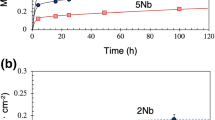Interaction in the Ni–HfB2 and NiCr–HfB2 systems is studied. No new reaction products are found to form in the system with pure nickel in solid-phase interaction up to the contact melting point. Solidphase interaction in the NiCr–HfB2 system resulting from the interdiffusion of boron from hafnium diboride and chromium from nichrome leads to a Cr2B layer in the contact area. Contact melting begins at 1370 ± 10°C in the Ni–HfB2 system and at 1450 ± 10°C in the NiCr–HfB2 system. The starting metals and Hf3Ni20B6 and Ni3Hf phases, including the Cr2Ni3B6 phase in the NiCr–HfB2 system, are basic products of the liquid-phase interaction in the hypoeutectic region of the phase diagrams of both systems. In the hypereutectic region of the phase diagrams, the metal component disappears and unreacted HfB2 appears additionally in the NiCr–HfB2 system. Both systems are eutectic and have eutectic melting points of 1370 ± 10°C for Ni–HfB2 and 1450 ± 10°C for NiCr–HfB2 at 20 ± 2% HfB2 in their quasibinary phase diagrams. Therefore, nickel and nichrome can be used to activate sintering since they act as a vanishing liquid phase. On the other hand, hightemperature oxidation-resistant hafnium diboride products can successfully perform in contact with nickel and nichrome products in the temperature range up to 1200°C.









Similar content being viewed by others
References
L. Silvestroni and D. Sciti, “Effects of MoSi2 additions on the properties of HfB2 and ZrB2 composites produced by pressureless sintering,” Scr. Mater., 57, No. 2, 165–168 (2007).
F. Monteverde and A. Bellosi, “The resistance to oxidation of an HfB2–SiC composite,” J. Eur. Ceram. Soc., 25, No. 7, 1025–1031 (2005).
G.L. Zhunkovskii, T.M. Evtushok, O.N. Grigor’ev, V.A. Kotenko, and P.V. Mazur, “Activated sintering of refractory borides,” Powder Metall. Met. Ceram., 50, No. 3–4, 212–216 (2011).
I.M. Fedorchenko and R.A. Andrievskii, Fundamentals of Powder Metallurgy [in Russian], Izd. Akad. Nauk USSR, Kyiv (1961), p. 420.
A.F. Lisovskii, Migration of Metal Melts in Sintered Composite Bodies [in Russian], Naukova Dumka, Kyiv (1984), p. 256.
A. Passerone, M.L. Muolo, F. Monteverde, and N. Sobczak, “Wetting and interfacial phenomena in Ni–HfB2 system,” Acta Mater., 57, 356–364 (2009).
Author information
Authors and Affiliations
Corresponding author
Additional information
Translated from Poroshkova Metallurgiya, Vol. 58, Nos. 11–12 (530), pp. 63–72, 2019.
Rights and permissions
About this article
Cite this article
Grigoriev, O.N., Znunkovskii, G.L. & Vedel, D.V. Interaction of HfB2 with Nickel and Ni–20% Cr Alloy (Nichrome). Powder Metall Met Ceram 58, 671–678 (2020). https://doi.org/10.1007/s11106-020-00124-x
Received:
Published:
Issue Date:
DOI: https://doi.org/10.1007/s11106-020-00124-x




